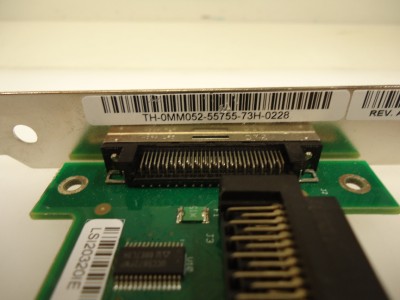- Lsi Scsi Controller Driver Mac
- Lsi Scsi Controller Driver Download
- Lsi 53c1030 Pci-x Scsi Controller Driver
- Lsi Ultra320 Scsi Driver
- Lsi Drivers Download
Mar 18, 2010 End Of Life - This download, LSI. Logic LSI20320I-R SCSI Adapter Bundle Windows. Driver 1.25.05.00, and older, will no longer be available after October, 28, 2019 and will not be supported with any additional functional, security, or other updates. All versions are provided as is. To access virtual disks, CD/DVD-ROM, and SCSI devices, a virtual machine uses storage controllers, which are added by default when you create the virtual machine. You can add additional controllers or change the controller type after virtual machine creation.
You can download the LSILogic SCSI controller driver from the download center at the LSILogic Web site. Download the LSIMPT adapter driver for your guest operating system. The downloaded driver zip archive also contains a text file that lists the instructions on how to install the driver during the installation of the Windows operating system. Our RAID controllers address virtually all direct-attached storage (DAS) environments – SATA or SAS, hard drives or solid state drives (SSDs).
Lsi Scsi Controller Driver Mac
I wrote a blog article in Oct 2010 on this same topic that is still frequently referenced today so I figure it was due for an update.
Lsi Scsi Controller Driver Download
So what should I choose as my vSCSI controller and what are the differences between them?
First, it’s important to remind everyone that when you select the Guest OS for a new virtual machine
- If you add a SCSI controller, you can reassign an existing or new hard disk or device to that controller. LSI Logic SAS and VMware Paravirtual SCSI are available for virtual machines with ESXi 4.x and later compatibility. On Windows guest operating systems, the driver must be installed and configured as the boot driver.
- LSI controllers Windows drivers were collected from official websites of manufacturers and other trusted sources. Original software will help you to fix device errors with LSI controllers. Download latest drivers for LSI controllers on Windows 10, 8, 7 (32-64 bit).
- Data center, cloud and high-performance computing environments not only require large amounts of storage capacity, they also must provide the data protection and performance today's applications and end users demand.
this automatically makes a selection for which vSCSI controller to use based on what drivers are available in the OS distribution. So be sure to select the correct Guest OS to start in the right place.
Lsi 53c1030 Pci-x Scsi Controller Driver
Let’s look at the options available today:
- BusLogic – this was one of the first emulated vSCSI controllers available in the VMware platform. The earliest versions of Windows has this driver available by default which made it easy when installing that particular OS. It wasn’t however as performant as the LSI Logic driver since Windows’ driver was limited to a queue depth of 1, so often one would manually load the LSI Logic driver instead. While still available and used occasionally (Is anyone still running Win2K?), it should be considered legacy.
- LSI Logic Parallel (formerly knows as just LSI Logic) – this was the other emulated vSCSI controller available originally in the VMware platform. Most operating systems had a driver that supported a queue depth of 32 and it became a very common choice, if not the default.
- LSI Logic SAS – This is an evolution of the parallel driver to support a new future facing standard. It began to grown popularity when Microsoft required its use for MCSC within Windows 2008 or newer.
- VMware Paravirtual (aka PVSCSI) – this vSCSI controller is virtualization aware and was been designed to support very high throughput with minimal processing cost and is therefore the most efficient driver. In the past, there were issues if it was used with virtual machines that didn’t do a lot of IOPS, but that was resolved in vSphere 4.1.

Are there performance differences between them?
- PVSCSI and LSI Logic Parallel/SAS are essentially the same when it comes to overall performance capability. PVSCSI, however, is more efficient in the number of host compute cycles that are required to process the same number of IOPS. This means that if you have a very storage IO intensive virtual machine, this is the controller to choose to ensure you save as many cpu cycles as possible that can then be used by the application or host. Most modern operating systems that can drive high IO support one of these two controllers.
- Here’s a detailed whitepaper that takes a closer look at PVSCSI vs LSI Logic SAS for IOPS, Latency and Cost. While it does support that PVSCSI is more capable, keep in mind most customers are not producing 1 million IOPS so for real life the difference is negligible.
Lsi Ultra320 Scsi Driver
How many vSCSI adapters are supported per virtual machine?
- It’s also worth noting that you can configure a total of 4 vSCSI adapters per virtual machine. To provide the best performance, one should also distribute virtual disk across as many vSCSI adapters as possible. This configuration provides the capability to process more IO simultaneously and benefit from additional queues if necessary.

What about AHCI SATA?
- This is a new storage controller available with vSphere 5.5 and virtual hardware 10. It allows you to connect a large amount of storage to a virtual machine but it wasn’t designed to be as efficient as the PVSCSI or LSI Logic controllers and therefore should not be used with performance sensitive applications.
Lsi Drivers Download
Let’ summarize this in a chart: